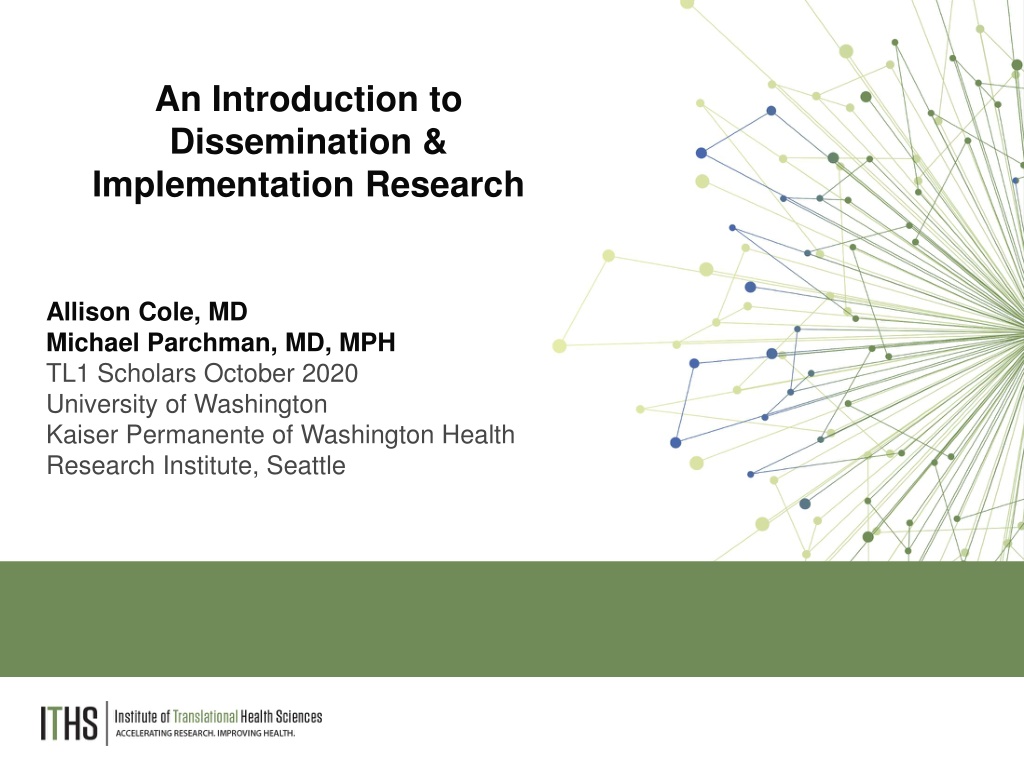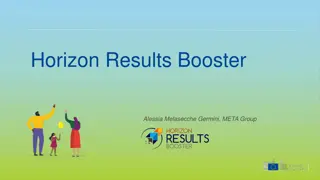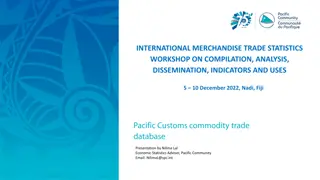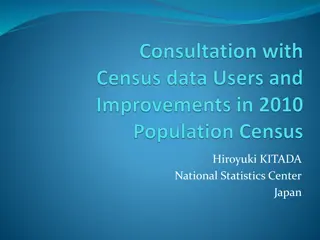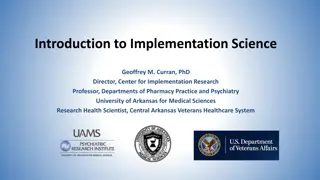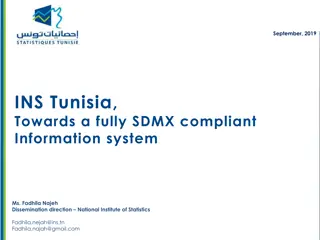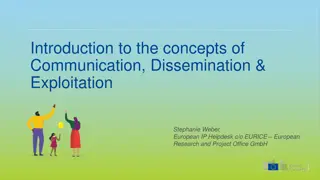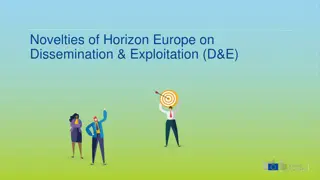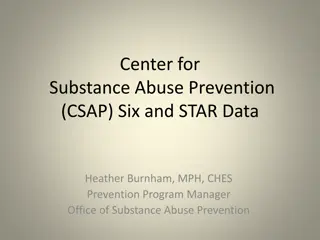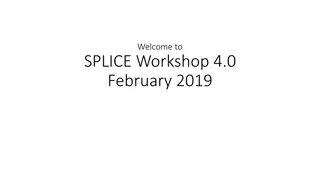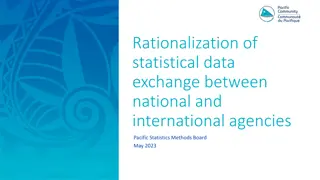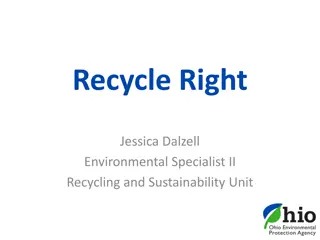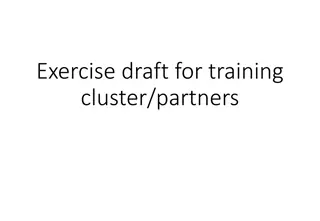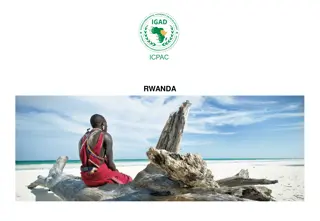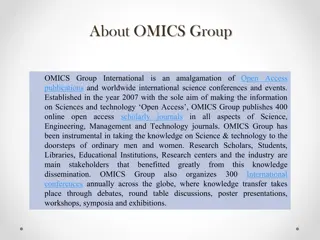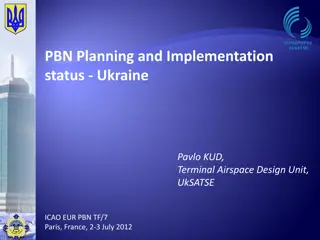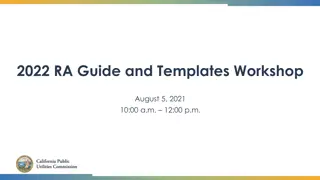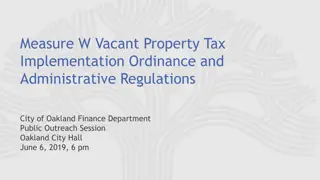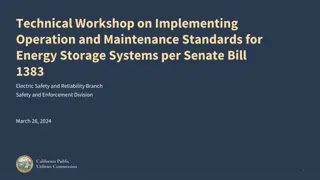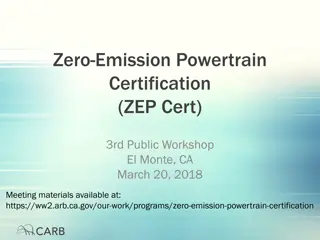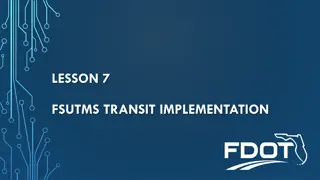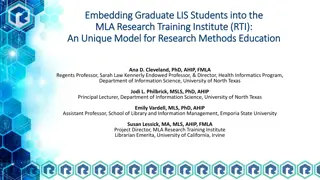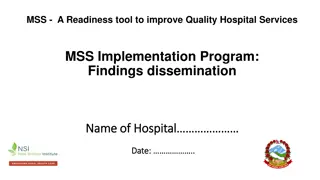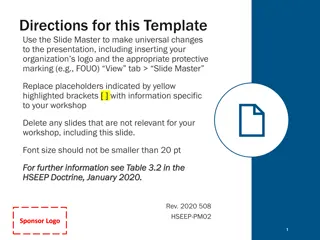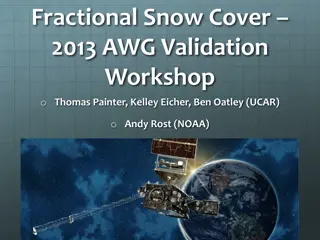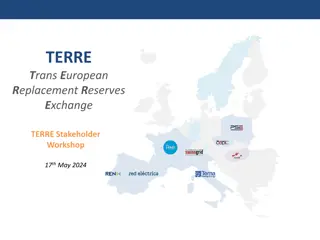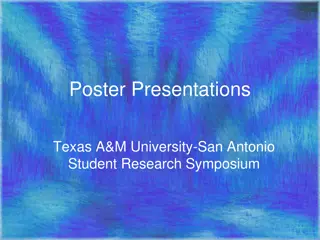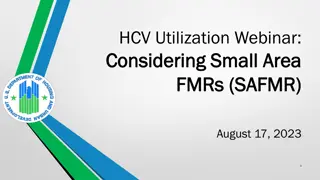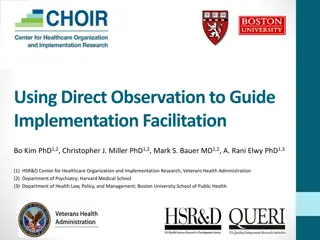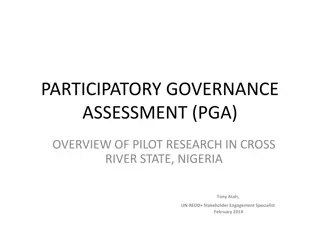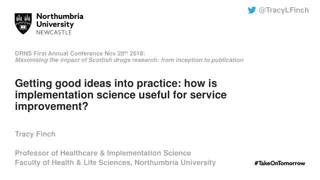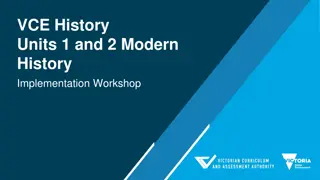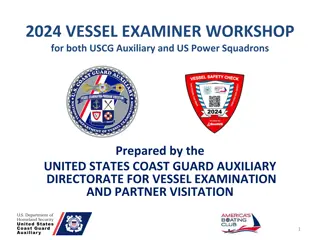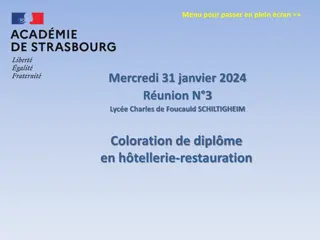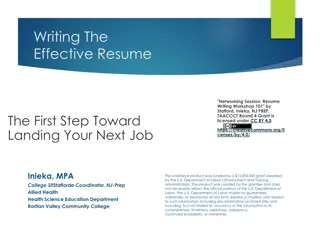Introduction to Dissemination & Implementation Research Workshop Overview
This document outlines the agenda, learning objectives, and key points of a workshop on Dissemination & Implementation (D&I) research. It covers topics like the application of D&I science in translational research projects, team-based principles, and the importance of effective interventions in healthcare. Participants engage in interactive sessions to enhance their understanding of implementing evidence-based care for better healthcare outcomes.
- Research Workshop
- Dissemination Science
- Implementation Research
- Healthcare Interventions
- Translational Research
Download Presentation

Please find below an Image/Link to download the presentation.
The content on the website is provided AS IS for your information and personal use only. It may not be sold, licensed, or shared on other websites without obtaining consent from the author. Download presentation by click this link. If you encounter any issues during the download, it is possible that the publisher has removed the file from their server.
E N D
Presentation Transcript
An Introduction to Dissemination & Implementation Research Allison Cole, MD Michael Parchman, MD, MPH TL1 Scholars October 2020 University of Washington Kaiser Permanente of Washington Health Research Institute, Seattle 1
Agenda DAY 2 Time Topic 8:00AM Icebreaker 8:05AM D&I Science Across Translational Science Spectrum Apply D&I Science principles to 3 TL1 Trainee projects: Shift and Share Activity 8:15AM 9:20AM Facilitator and Trainee Reflection 9:25AM Report Out 9:45AM Introduction of Experiential Learning Opportunities 9:59AM Evaluation
Disclosures/Conflicts of Interest I have nothing to disclose I have no conflicts of interest 3
Ice Breaker Take 1 minute to TYPE your answer into the chat box for the following question. DO NOT hit enter. What resonated with you from Day 1 of the D and I Science Workshop? 4
Application of Dissemination and Implementation Science Across the Translational Research Spectrum 5
Learning Objectives By the end of these sessions, you will be able to 1) Describe how D&I science fits into the continuum of translational research 2) Provide examples of how D&I science principles apply to translational research projects 6
Recap from Day 1: Key Points Failure to implement evidence-based care and effective interventions contributes to poor healthcare outcomes in the U.S. The biggest gap in adoption of new interventions is between the early adopters and the early majority. Implementation science principles can help overcome this chasm. The CFIR framework provides a useful structure for considering aspects of a clinical environment and an intervention that impact the likelihood of successful implementation. 7
Core Principles from D&I Science 1) Context matters and it is multi-level 2) To improve health, interventions must be both effective and useable 3) Change happens proactively 4) Dissemination and Implementation are team endeavors 8
Integrative Framework of Dissemination, Implementation & Translation Public Health D&I Sciences Clinical Implementation Basic Research D&I Principles Pre-Clinical Research Clinical Research
How D&I Science Principles Can Improve the Process of Translation (moving to the next stage) Application of D&I Principles Engage stakeholders and understand stakeholder needs for a potential clinical intervention Design a clinical intervention (e.g. drug, device) to meet these needs Basic research to pre- clinical research Identify potential barriers to use of a new clinical intervention Modify the intervention, setting or research design to address barriers Pre-clinical research to clinical research Select and understand the clinical settings for implementation Plan strategies for successful implementation Clinical research to clinical implementation Compare implementation approaches Develop sustainability plans Clinical implementation to public health 10
Example: Glycomacropeptide-based food for PKU Clinical problem - Individuals with PKU cannot metabolize phenylalanine, must follow strict diet Basic science isolated glycomacropeptide (GMP) as a by- product of cheese making. Discovered it is phenylalanine free. Stakeholder engagement outreach to National PKU Alliance, gauge interest in GMP-based food products, -confirmed future demand for GMP-based food products 11
Example: Glycomacropeptide-based food for PKU Created a multi-stakeholder Task Force Multiple stakeholders involved in task force, oversaw all aspects of the program Mouse studies demonstrated safety and efficacy Human studies demonstrated safety and efficacy University of Wisconsin Dairy Research Center Developed palatable GMP-based food products with input from patients and family members of patients with PKU PKU community supported rapid deployment of clinical trials University of Wisconsin Foundation provided commercialization support 12
PKU Outcome Now a local company manufactures GMP-based foods, which accounts for 10% of food consumed by PKU patients Increased variety and quality of food offerings for these patients 13
Applying Principles of Dissemination and Implementation Sciences to TL1 Scholar Projects 14
Breakout Sessions Session Outline Learn about three TL1 Scholar projects Participate in facilitated small group discussions with each Scholar Report back about your discussions with the whole group Activities and Goals Brainstorm solutions to potential implementation challenges Learn about applications of D&I Sciences to solve challenges 15
Shift and Share Presentations Before the start of the session identify presenters translational researchers who are willing to present their work briefly and engage in discussion about how implementation science can apply to their work Divide into 4 groups -Translational researcher provides 3-4 minute project overview 1. Name, project title 2. Study background, study goal, translational research stage 3. Study methods 4. Potential challenges to translation or clinical implementation -Facilitator asks group to help identify additional potential challenges -Facilitator asks group to brainstorm potential solutions, drawing on the approaches shared in Slide 10 16
An Introduction to Dissemination & Implementation Research TL1 Scholars October 2020 PROJECT TITLE SCHOLAR NAME DEPARTMENT 17
PROJECT TITLE Study Background Describe Describe Study Goal: Describe Translational Research Stage: Describe 18
PROJECT TITLE Study Methods Describe Describe Describe 19
PROJECT TITLE Potential Challenges to Translation or Clinical Implementation Describe Describe Describe 20
Shift and Share Discussions In the breakout group you ll discuss challenges and brainstorm solutions on each Scholars project. 2. 3. 1. You will be randomly assigned to a breakout group for a discussion with each of the Scholars in turn. 15 minute discussion with Scholar 1 You will be returned to the main call 15 minute discussion with Scholar 2 There will be a 5 minute break and then the report out session will begin 15 minute discussion with Scholar 3 21
Report Out! For each trainee Did the groups identify any new challenges? Which challenges do you think are most critical to focus on? What solutions did you discuss? What made these a good fit? How did you or could you integrate D&I science principles into the solutions? 23
Core Principles from D&I Science 1) Context matters and it is multi-level 2) To improve health, interventions must be both effective and useable 3) Change happens proactively 4) Dissemination and Implementation are team endeavors 24
We will present the opportunities today Over the next week, you will choose one of these activities by completing the survey that is sent to you
Schedule for Experiential Learning Date Timeline Dec 1, 2020 Orientation to your chosen experiential learning opportunity Jan 26, 2021 Shared learning session with others completing the same opportunity (Midpoint check-in) Feb 23, 2021 5-minute Capstone presentations of your work (slide template will be provided)
Apply D&I to TL-1 Trainees work Three experiential opportunities: 1. Design a stakeholder assessment 2. Plan one step in implementing an intervention in clinical or community-based settings 3. Create a dissemination plan for TL1 Trainees research product/s
Design A Stakeholder Assessment Learning objectives: Identify stakeholder(s) who might impact or influence the implementation or dissemination of an innovation Analyze how the innovation might be impacted or influenced by stakeholder(s) Create strategies to engage appropriate stakeholder(s) Outcome: By the conclusion of this exercise, trainees will be able to identify stakeholders who will need to be engaged if efforts to implement or disseminate a clinical innovation are to be successful.
Process For Conducting a Stakeholder Assessment Trainees will 1. Read a case study and watch a YouTube video example of a stakeholder assessment. 2. Based on your own project, identify at least 3 stakeholders you might need to engage by completing the Stakeholder Management Log. Brainstorm questions you might ask each of the potential stakeholders. 3. Use the stakeholder assessment questions to map these stakeholders on a Stakeholder Grid, given what you know about these stakeholders. 4. Based on your assessment, describe in 2-3 sentences who you might need to engage as stakeholders and what you might do to engage them. Optional Extensions 1. Ask one of your classmates to role-play one of the stakeholders relevant to your project and do a phone interview with your classmate. 2. Reach out to one of the stakeholders relevant to your project and complete a phone interview.
Plan Implementation of an Intervention Learning objectives: Understand the steps in planning implementation of a health innovation or intervention in clinical or community-based settings Apply principles of D&I science to one implementation planning step Outcome: By the conclusion of this exercise, trainees will be able to apply principles of D&I science to the process of planning implementation of a health innovation in clinical or community- based settings.
Process for planning a component of a clinical or community-based intervention implementation Trainees will use the Implementing Health Innovations in Clinical Practice toolkit to undertake these activities 1. Work with the D&I team to select an activity and prepare to complete it 2. Complete a planning worksheet for your project. Choose one: Understanding your intervention: Describe the key components of your intervention or innovation Operationalizing implementation: Create an action plan for using one implementation strategy Optional Extension Complete both planning worksheets
Create a dissemination plan for your research product/s Learning objective: Apply principles of dissemination to distribute trainees research product/s to a target audience Outcome: By the conclusion of this exercise, trainees will create a real-world dissemination plan for their research product/s
Process for creating a dissemination plan for your research product/s Trainees will use an adaptation of the Health Promotion Research Center s Dissemination Workbook to 1. Identify the research product/s they want to disseminate 2. Identify appropriate users of their research product/s 3. Identify whether there are disseminating organizations that might best reach their users 4. Develop a marketing message for their product/s and tailor it to their users 5. Put together a proposed dissemination plan Optional Extension 1. Implement some element/s of the dissemination plan In real-world settings.
How to decide which learning opportunity to choose Choose: If: Stakeholder Assessment .you want to learn who might be your allies and what obstacles there might be in implementing or disseminating your innovation A good choice for scholars working at any translational stage .you expect to have an intervention ready for implementation A good choice for scholars working at the clinical or public health stages of translational science ...you think you will have a research product that you want to move to the next phase of translation either in research, the clinic, or the community A good choice for scholars working at any translational stage Planning Implementation Dissemination Plan Development
Next Steps You will receive a survey asking you to rank your preferences for joining the three experiential learning opportunities. Please respond to the survey by November 5 You can preview the materials for each of the experiential learning opportunities by going to Course Canvas Page
Next Steps By November 10, you will learn which opportunity you will join
For Additional Questions, please email: NAME EMAIL
You will receive an email to complete a post- workshop evaluation 39
Thank You ITHS is supported by the National Center For Advancing Translational Sciences of the National Institutes of Health under Award Number UL1 TR002319. This project was supported by the National Center For Advancing Translational Sciences of the National Institutes of Health under Award Number TL1 TR002318. The content is solely the responsibility of the authors and does not necessarily represent the official views of the National Institutes of Health.
